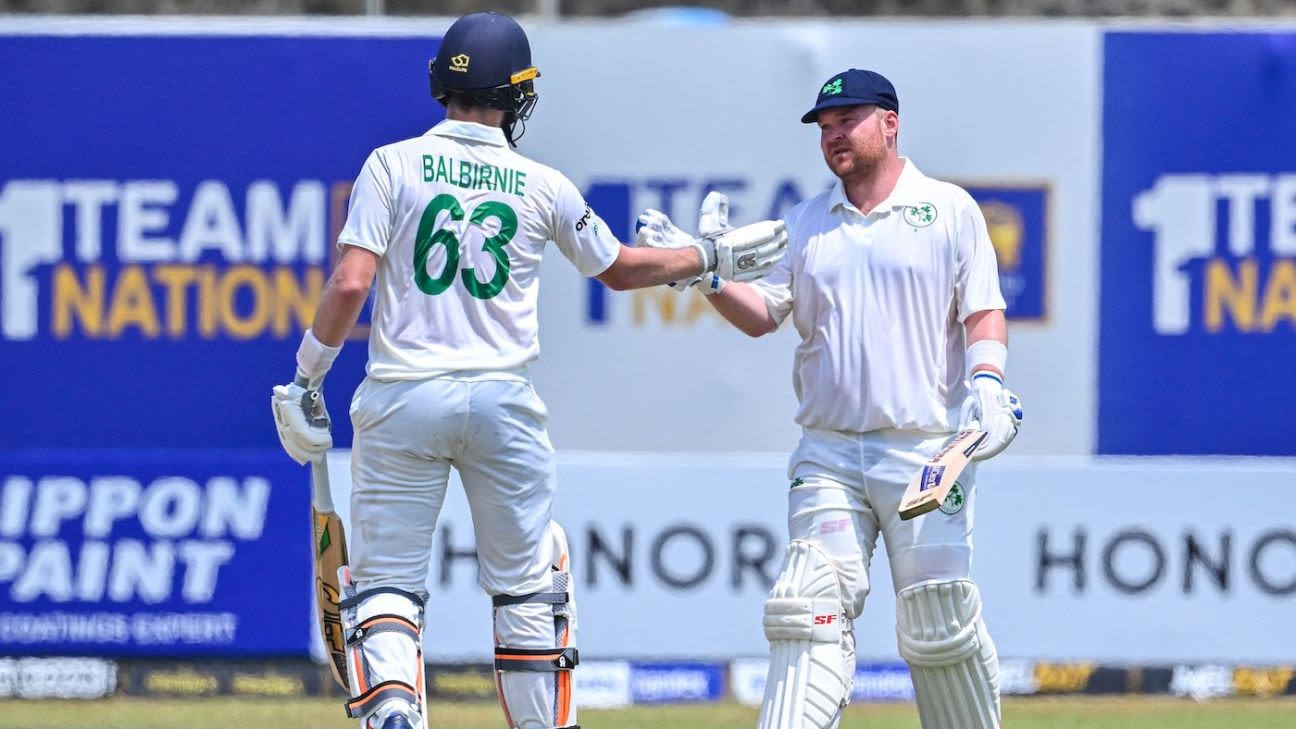Balbirnie, Stirling and Tucker take Ireland past 300
Ireland 319 for 4 (Balbirnie 95, Tucker 78*, Stirling 74) vs Sri Lanka
Balbirnie’s was a gripping innings, particularly in his first 60 balls. He was off the mark with a three, having punched Asitha past mid off. Though Ireland had again lost an early wicket, he was clearly intent on reversing pressure.
If Ireland are a side far more comfortable playing white-ball cricket, here was a knock that played to that strength. Balbirnie was severe on errors of length, looking to attack on the front foot when the bowlers pitched even marginally full, just as quick to get back when they went too short. His first boundary was through extra cover off Vishwa – the fifth ball he faced. Later in that opening exchange, he hit Vishwa for three boundaries in four balls – the first two timed perfectly, through the covers then backward of point. The third a thick edge that slipped between the cordon and gully. In the early stages, this was not an innings that took prisoners.
Two further wickets fell at the other end. When James McCollum was out for 10, the team score on 43, Balbirnie had 26. When Harry Tector holed out to mid on – Dinesh Chandimal taking a good overhead catch – the team score was 89 and Balbirnie had 54 of those runs, having got to his half-century off 43 balls, with a boundary through point, obviously.
But then Stirling came in, and later that over, nailed his third ball for six over deep square leg – a full-blooded slog sweep. At Galle, even great Test batters resort to playing limited-overs style cricket, reasoning they may as well score all the runs they can before the unplayable ball comes along. This pitch was far from unplayable yet, but for Ireland, this was a sound way forward. Stirling was not as quick to his half-century as Balbirnie. He took all of 64 deliveries.
Between them, they set the tone for Ireland’s day. Balbirnie loved the cover region, hitting six of his 14 fours in that area, though there were also plenty of boundaries behind the wicket, either side, some unintended. Stirling was more of a legside guy. He hit three sixes, all in the arc between backward square leg, and uhh, forward square leg. One was even off a seamer, a shortish ball outside off stump, which Stirling went back and across to, and dumped into the bank.
But then either side of tea, Stirling began to visibly suffer with cramp, sometimes wearing short balls on the body, partly because he could not turn fast enough to play those deliveries (these were from seamers). Third over after tea, he collapsed – not for the first time – after facing a delivery, and retired hurt for 74 off 133 balls.
Although Stirling had been with Ireland in Bangladesh, he only arrived in Sri Lanka several days ago, after the first Test had wrapped up. As such he had not had as much time to become acclimatised. April is generally the hottest month in this part of the country.
He and Balbirnie had done the tough work, though, and Tucker was well placed to capitalise. Balbirnie fell five short of what would have been his first, and Ireland’s third, Test century. It was a tired stroke, really – he swept way too early against a Ramesh Mendis offbreak that pitched on middle, and the ball ended up popping off the back of the back of the bat to Dhananjaya de Silva at slip.
Tucker tore on. Having swept his first ball against spin for four (attacking your way into some rhythm seemed a theme for Ireland), he moved to 20 off 30 balls. In that time, he survived an extremely close lbw shout against Asitha – Sri Lanka’s review showing umpire’s call on impact, but not by much.
But eventually, Tucker began to prosper, almost exclusively behind the wicket, relying on a wicketkeeper’s favourite strokes – the sweep and the cut. By close, 50 of his runs had come behind the wicket. Sri Lanka’s bowlers – the spinners included – were beginning to show signs of fatigue themselves, though they got through their full quota of overs for the day.
Tucker got to fifty off his 71st delivery, flicking Vishwa through backward square leg for four. And he ended the day Ireland’s top Test run-scorer by four runs, beating Balbirnie who has 270 in his career.
Andrew Fidel Fernando is ESPNcricinfo’s Sri Lanka correspondent. @afidelf
For all the latest Sports News Click Here

